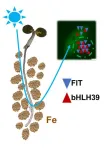(Press-News.org) Iron is a micronutrient for plants. Biologists from the Institute of Botany at Heinrich Heine University Düsseldorf (HHU) describe in a study, which has now been published in the Journal of Cell Biology, that regulatory proteins for iron uptake behave particularly dynamically in the cell nucleus when the cells are exposed to blue light – an important signal for plant growth. They found that the initially homogeneously distributed proteins relocated together into “biomolecular condensates” in the cell nucleus shortly after this exposure.
Both iron deficiencies and excesses are problematic for plants. They need the micronutrient for photosynthesis and enzymatic reactions. A lack of iron leads to yellowing of the plants and reduced growth, while an excess can result in cell damage. A well-balanced iron uptake must therefore be in place to ensure a healthy plant life.
Once the plant has an iron deficiency, a signalling cascade is activated and more iron is taken up via the roots. Proteins that regulate particular genes (so-called transcription factors) play an important role in this process.
A research team from the Institute of Botany at HHU headed by Professor Dr Petra Bauer has examined the cellular localisation of the transcription factors involved in iron uptake, concentrating in particular on an essential transcription factor within the iron signalling cascade called “FIT”.
To date, very little research has been conducted into where in the nucleus the transcription factors occur in the plant cell. However, knowing this would aid understanding of the function of the protein. Whether the localisation can change is also relevant, as this may be part of a regulatory mechanism that acts on the protein.
The study, which has now appeared in the Journal of Cell Biology, found that FIT is a dynamic protein that can localise in membrane-less sub-compartments – so-called biomolecular condensates – within the cell. The authors consider these sub-compartments regulatory hubs that enable spatially and temporally flexible platforms for signalling and interaction.
The biologists found that FIT specifically accumulates in condensates within the cell nucleus when the plant cells have been exposed to blue light. They examined blue light in particular as it is an important environmental signal for the plant and iron uptake.
The formation of condensates of certain light-regulated proteins has already been described. Biomolecular condensates arise when protein complexes accumulate locally. However, a connection with components relevant for nutritional physiology like FIT was not previously known to exist. It was unclear whether FIT condensates can contribute to the organisation and efficiency of cellular processes. To this end, the researchers in Düsseldorf examined the interactions between FIT and other proteins in nuclear condensates in more detail. They found that not only transcription, but also regulation of the mRNA – i.e. of the sections of genetic material that are read from the DNA to control processes – may take place in the condensates.
“For the first time, I observed accumulations of FIT proteins in the form of condensates during laboratory work on a master’s module project, which posed the simple question of why this is so,” says lead author Dr Ksenia Trofimov (now Krooß). This was the start of a major research project: “When we saw these condensates forming, we barely had any idea of what the function could be as the research topic of condensates was just emerging within the plant field. The original question gave rise first to my master’s work and then my doctoral thesis.”
Professor Bauer adds: “This work has led to a new aspect in plant nutrition. We now need to further explore how these condensates are integrated into the signalling cascades of iron uptake and how environmental cues such as light are able to control iron uptake in a fast and dynamic way.”
The extensive microscopy study was made possible by the Center for Advanced Imaging (for short: CAi), a high-performance, inter-faculty imaging facility at HHU.
Original publication:
Ksenia Trofimov, Regina Gratz, Rumen Ivanov, Yvonne Stahl, Petra Bauer, and Tzvetina Brumbarova, Corresponding Author(s): Petra Bauer, Heinrich Heine University Duesseldorf. FER-LIKE IRON DEFICIENCY-INDUCED TRANSCRIPTION FACTOR (FIT) accumulates in nuclear condensates, Journal of Cell Biology (2024).
DOI: 10.1083/jcb.202311048
END
Biomolecular condensates – regulatory hubs for plant iron supply
Botany: Publication in the Journal of Cell Biology
2024-02-23
ELSE PRESS RELEASES FROM THIS DATE:
PolyU researchers introduce biomineralization as a sustainable strategy against microbial corrosion in marine concrete
2024-02-23
Microbially induced corrosion (MIC) is a prevalent issue in marine environments, leading to structural damages such as cracking in concrete infrastructure. This corrosion poses a persistent challenge, significantly reducing the lifespan of marine structures and resulting in substantial economic losses. In response to the need for an effective solution to combat the marine corrosion on concrete, researchers of the Hong Kong Polytechnic University have developed a biomineralization approach to protect marine concrete from MIC.
Prof. ...
Genes affect your blood pressure from early childhood
2024-02-23
Certain genes associated with hypertension affect blood pressure from early in life, and they increase the risk of cardiovascular disease as you get older. However, you can do something about it.
“We are talking about really small differences, so small that they may fall within what is considered normal blood pressure. The problem is that they tend to last your whole life,” says PhD Candidate Karsten Øvretveit at the Norwegian University of Science and Technology's (NTNU) Department of ...
Streams connected to groundwater show improved detoxification and microbial diversity
2024-02-23
Washington, D.C. — Feb. 23, 2024 —Streams with ample connections to shallow groundwater flowpaths have greater microbial diversity and are more effective at preventing toxic forms of metals—often products of upstream mining—from entering and being transported downstream. These streams are also better at detoxifying those metals already present. The research is published this week in Applied and Environmental Microbiology, a journal of the American Society for Microbiology.
Under favorable conditions, the zone lining a stream channel stores nutrients and oxygen that meet nutritional and respiratory needs of local invertebrates and fish. That ...
Almodóvar receives NIH grant to study pulmonary hypertension in HIV patients
2024-02-23
Across the globe, more than 39 million people are living with the Human Immunodeficiency Virus (HIV), the virus that causes AIDS, including more than 1.3 million new HIV diagnoses last year. The majority of those afflicted — approximately 76% — have access to antiviral therapy that allows them to live with HIV as a chronic disease.
Sharilyn Almodóvar, Ph.D., from the Department of Immunology and Molecular Microbiology at the Texas Tech University Health Sciences Center (TTUHSC) School of Medicine and the TTUHSC Graduate School of Biomedical Sciences, said that even with the widespread ...
SK bioscience’s typhoid conjugate vaccine achieves WHO prequalification
2024-02-23
WHO PQ paves the way for public procurement of SKYTyphoid™ by UN organizations
Addition of new vaccine will diversify, expand TCV supply amid expected growing demand
February 23, 2024, SEOUL, Korea – SK bioscience and the International Vaccine Institute (IVI) announced today that the typhoid conjugate vaccine developed by SK bioscience with technology transfer from IVI has achieved the World Health Organization prequalification (PQ), which paves the way for public procurement of the vaccine by UN organizations and gives a boost to the global TCV supply.
WHO PQ certifies the safety, efficacy, and GMP of a vaccine by evaluating its manufacturing ...
The American College of Medical Genetics and Genomics (ACMG) releases points to consider statement on the safety and efficacy of polygenic risk score assessment for embryo selection
2024-02-23
Should we be using polygenic risk score assessment for embryo selection? Providing in-depth analysis, the Social, Ethical and Legal Issues Committee of the American College of Medical Genetics and Genomics (ACMG) has released a new Points to Consider statement to assist healthcare professionals and patients in understanding the safety and utility of preimplantation genetic testing for polygenic disorders (PGT-P) as a clinical service.
“Clinical Utility of Polygenic Risk Scores for Embryo Selection: A Points to Consider Statement of the American College of Medical Genetics and Genomics (ACMG)” was published in the College’s flagship journal, Genetics ...
PolyU researchers introduce biomineralisation as a sustainable strategy against microbial corrosion in marine concrete
2024-02-23
Microbially induced corrosion (MIC) is a prevalent issue in marine environments, leading to structural damages such as cracking in concrete infrastructure. This corrosion poses a persistent challenge, significantly reducing the lifespan of marine structures and resulting in substantial economic losses. In response to the need for an effective solution to combat the marine corrosion on concrete, researchers of the Hong Kong Polytechnic University have developed a biomineralization approach to protect marine concrete from MIC.
Prof. ...
UBC Okanagan researchers look to the past to improve construction sustainability
2024-02-23
Researchers at UBC Okanagan are revisiting old building practices—the use of by-products and cast-offs—as a way to improve building materials and sustainability of the trade.
A technique known as rammed earth construction uses materials that are alternatives to cement and are often more readily available in the environment. One such alternative is wood fly ash, a by-product of pulp mills and coal-fired power plants, explains Dr. Sumi Siddiqua, with UBC Okanagan’s School of Engineering.
Industry has been trying to find a use for materials like fly ash ...
New study identifies potential gene targets for management of cassava whitefly, key vector of viral diseases threatening African food security
2024-02-23
Whiteflies, particularly the African cassava whitefly (Bemisia tabaci, SSA1-SG1), pose a significant threat to agricultural productivity in Sub-Saharan Africa by transmitting viruses that cause cassava brown streak disease and cassava mosaic virus disease. In a new study published in PeerJ Life & Environment, Dr. Tadeo Kaweesi and his team at the National Agricultural Research Organization identify potential gene targets that could revolutionize the management of this devastating pest and prove vital for food security in the region.
In the article ("In silico prediction of candidate gene targets ...
Twin, the new robotic exoskeleton for lower limbs
2024-02-23
Milan (Italy), 23 February 2024 – TWIN is the name of the new robotic exoskeleton for lower limbs, designed and developed by Rehab Technologies IIT – INAIL, the joint laboratory between the Istituto Italiano di Tecnologia (IIT-Italian Institute of Technology) and the Prosthetic Center of INAIL (the prosthetic unit of the National Institute for Insurance against Accidents at Work), which will allow patients to wear it more easily. Presented today in Milan during a press conference held at the Museum of Science and Technology, TWIN was demonstrated ...
LAST 30 PRESS RELEASES:
Making lighter work of calculating fluid and heat flow
Normalizing blood sugar can halve heart attack risk
Lowering blood sugar cuts heart attack risk in people with prediabetes
Study links genetic variants to risk of blinding eye disease in premature infants
Non-opioid ‘pain sponge’ therapy halts cartilage degeneration and relieves chronic pain
AI can pick up cultural values by mimicking how kids learn
China’s ecological redlines offer fast track to 30 x 30 global conservation goal
Invisible indoor threats: emerging household contaminants and their growing risks to human health
Adding antibody treatment to chemo boosts outcomes for children with rare cancer
Germline pathogenic variants among women without a history of breast cancer
Tanning beds triple melanoma risk, potentially causing broad DNA damage
Unique bond identified as key to viral infection speed
Indoor tanning makes youthful skin much older on a genetic level
Mouse model sheds new light on the causes and potential solutions to human GI problems linked to muscular dystrophy
The Journal of Nuclear Medicine ahead-of-print tip sheet: December 12, 2025
Smarter tools for peering into the microscopic world
Applications open for funding to conduct research in the Kinsey Institute archives
Global measure underestimates the severity of food insecurity
Child survivors of critical illness are missing out on timely follow up care
Risk-based vs annual breast cancer screening / the WISDOM randomized clinical trial
University of Toronto launches Electric Vehicle Innovation Ontario to accelerate advanced EV technologies and build Canada’s innovation advantage
Early relapse predicts poor outcomes in aggressive blood cancer
American College of Lifestyle Medicine applauds two CMS models aligned with lifestyle medicine practice and reimbursement
Clinical trial finds cannabis use not a barrier to quitting nicotine vaping
Supplemental nutrition assistance program policies and food insecurity
Switching immune cells to “night mode” could limit damage after a heart attack, study suggests
URI-based Global RIghts Project report spotlights continued troubling trends in worldwide inhumane treatment
Neutrophils are less aggressive at night, explaining why nighttime heart attacks cause less damage than daytime events
Menopausal hormone therapy may not pose breast cancer risk for women with BRCA mutations
Mobile health tool may improve quality of life for adolescent and young adult breast cancer survivors
[Press-News.org] Biomolecular condensates – regulatory hubs for plant iron supplyBotany: Publication in the Journal of Cell Biology






